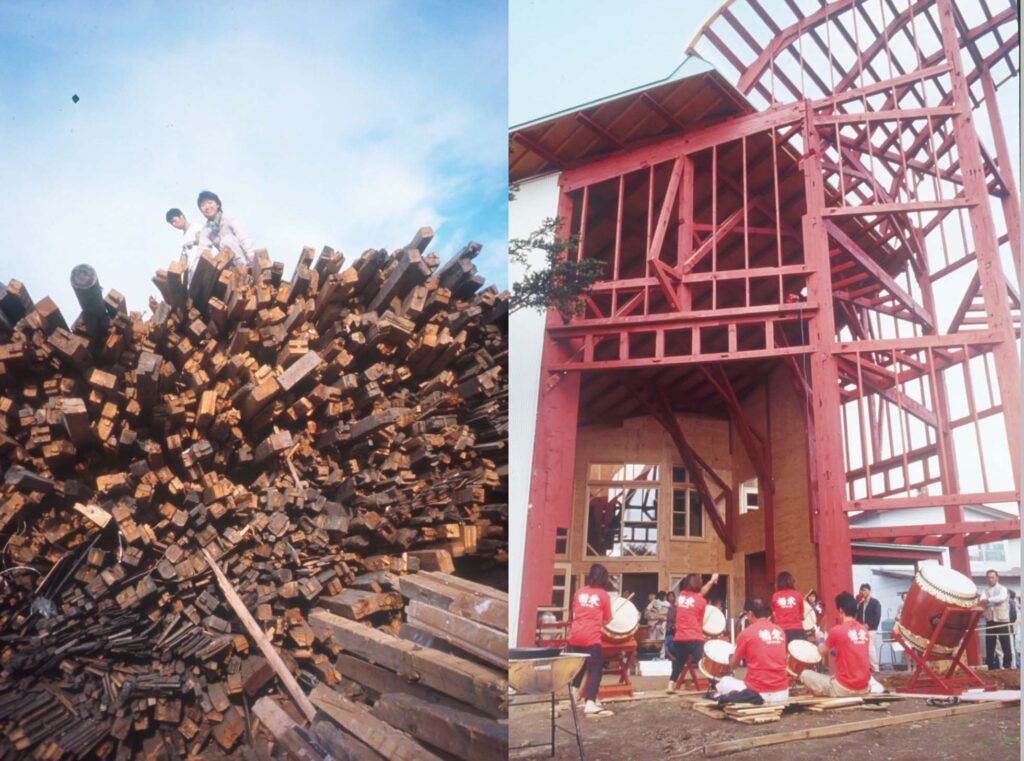- 場所の表現◎Expression of Place◎在地性的表現
- 住居とは何だろう? 学校とは? 道とは?◎What is a House? What is a School? What is a Road? ◎何謂住家? 何謂學校? 何謂道路?
- 多様性◎Diversity◎多樣性
- 五感に訴える◎Sensory World◎訴諸五官感受
- 自然を受けとめ、自然を楽しむ◎Enhancing and Enjoying Nature◎接受自然、享受自然
- あいまいもこ◎Aimaimoko◎曖昧模糊
- 自力建設◎Exertive Building◎自力建設
1 場所の表現
私たちは、建築がその建つ場所を映し出すことを望んでいます。デザインが場所や地域の固有性を表現するよう努めます。村を歩きまわり、景観を調査して、土地が培ってきた表情を学びます。人々の暮らしを見つめ、土地の歴史を調べます。このようにして、デザインのなかにその場所らしさを表現するための鍵やきっかけを掘り起こしてゆきます。
1 Expression of Place
It is our desire that the architecture reflect the place of where it stands. We attempt to express the identity of the area or region in what we design. We walk around the village, survey the landscape, observe how people are living and investigate the local history. In this way we eventually uncover clues or keys for expressing the locality in our designs.
1 在地性的表現
我們希望建築能反映出當地的個性。所以設計時會盡力地表現出建築所在地的特性及本質。在社區四處走動、觀察社區的風景、關注人們的生活、調查土地的歷史,就可以從中學習到這片大地孕育至今的表情。經歷這種過程,才能在設計中掌握表達在地性的關鍵及契機。
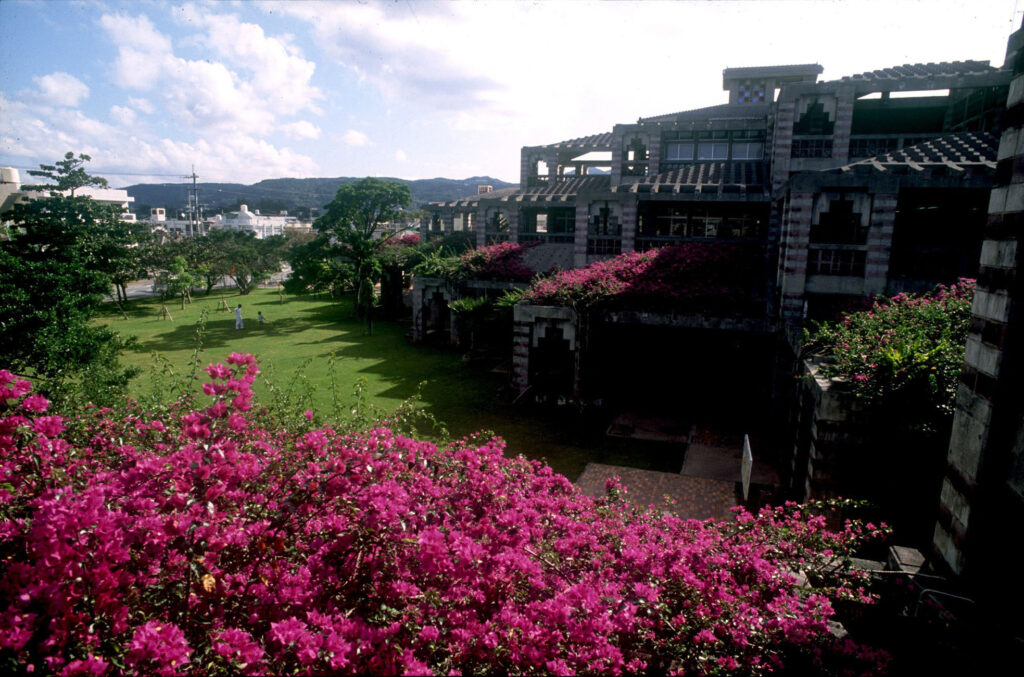
2 住居とは何だろう? 学校とは? 道とは?
コミュニテイ、学校、家族の基本的な生活のありさまをよく観察して、人々がつくろうとしているものの根本的な要求を知ることが出発点になります。時に人々は、自分たちの欲求や希望をはっきりとは自覚していないことがあります。そこで、人々と共に考え、新しい生活のしかたを提案していくことが、象の仕事の重要な部分となります。私たちの目標は、人々の今日の要求を満たす空間を創り出すこと、と同時に、その人たちの生活の地平を広げるための新たな機会を提供することです。
2 What is a House? What is a School? What is a Road?
We observe the basic living process of a community, a school or a family, and try to find the fundamental demands for the architecture they plan to build. At times, the client or community is not fully aware of their own wants or needs. It becomes a part of our work to think with them and to propose a plan for their new way of life. Our objective is to create spaces that answer the current demands of the client and community, while providing new opportunities to broaden the horizons of life.
2 何謂住家? 何謂學校? 何謂道路?
仔細觀察社區、學校、家庭的基本生活情況,藉此了解人們想追求的生活,以及什麼是造成他們追求此種生活的根本需要,這些將成為我們設計時的出發點。有時人們會無法清楚認識自己真正的欲求及希望,所以,和人們共同思考,提出新生活的可能性就成為象工作中的重要部分了。我們的目標是創造出可以滿足人們現今需求的空間,並同時提供能夠拓展他們的生活領域的新機會。
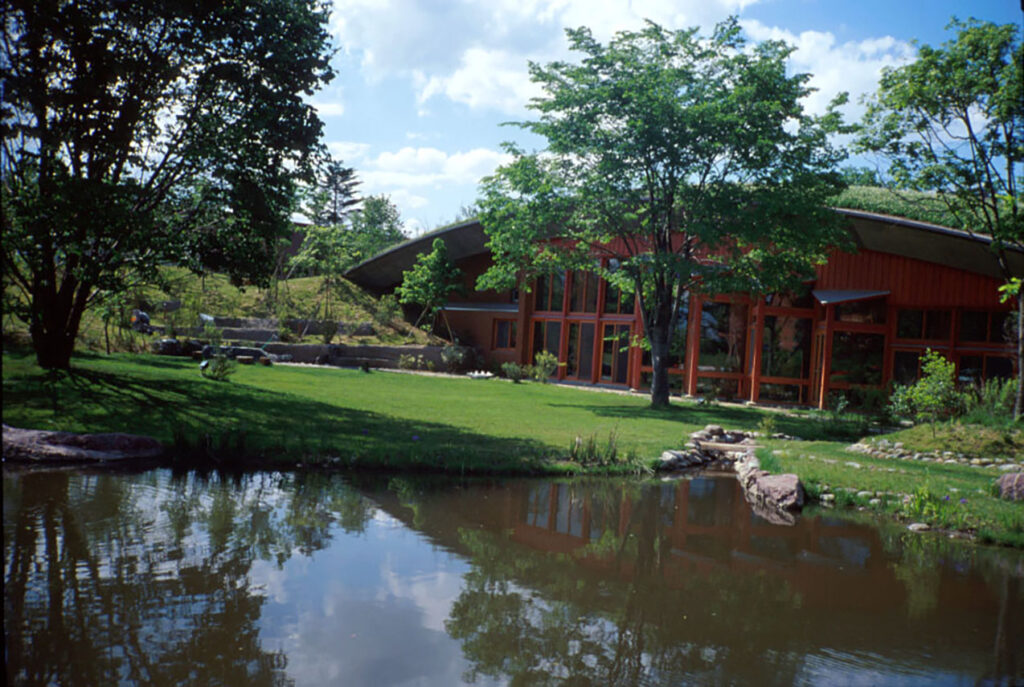
3 多様性
建築とは人々の出会いです。多様な空間特性が総合的に組み立てられた環境の中では、その環境を媒介にしてさまざまな出会い─人と人の、あるいは人と物の─が生まれます。私たちは計画する空間の中に形態、素材、スケールの多様性とそれらを結び付ける秩序を用意します。そこにやってくる個々の人が、強く引きつけられる部分や全体を発見し、それを共有する人の存在に気づき、そして共に平和を信じることができるよう願っているのです。これは均質で画一的な空間の中では期待できないことです。
3 Diversity
Architecture is an opportunity for various people to meet. Spaces affect how people make contact. Integrating spatial diversity into the structures, provides a variety of environments where people can interact. By communicating diversity in form, materials and scale, we seek to develop in people using the architecture a sense of recognition and peace.
3 多樣性
建築意味著人與人的相遇。在一個由多樣空間特性綜合組成的環境中,人與人或人與物將以此環境作為媒介,誕生各式各樣的邂逅。我們在規劃中的空間準備好各種不同的形態、素材與規模,以及連結這些東西的嶄新秩序。期望每個來到此地的人都能從中發現強烈吸引自己的空間整體,或其中的一小部分,然後察覺到有共享此空間的人的存在,進而一起相信人們能和平共存。而這種理想在一個單調而統一的空間中,是絕對無法達成的。
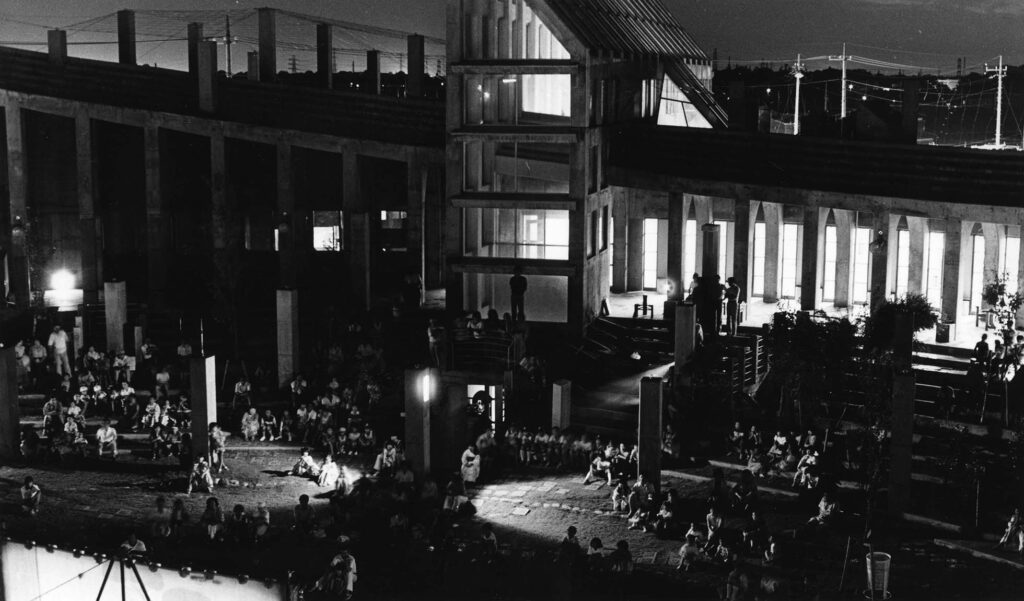
4 五感に訴える
私たちは、人々の情感に強く訴える環境をつくりたいと考えています。人々が、光と影、音、香り、手ざわりや足ざわり、運動感覚を通じて空間の特性を感じ取り、さらにその外の世界とのつながりに心を向けてほしいと願うのです。私たちが用いる素材や形は、自然の要素を表現していることがよくあります。風、水、太陽、星、そして遠くに見える山を直接的に導入します。建築的な空間とは感覚的な体験であると思います。
4 Sensory World
We design an environment to inspire an emotional response from the people. Upon entering our structures, people should experience some slight shock or stimulation of their five senses in order to alert them to the character of the space and its connection with the outside world. The textures of materials and the forms we use within the space often represent the natural elements on the outside. Wind and water, sunlight and starlight, or a distant mountain view, are transmitted into the space in a very direct way. We utilize the organization of the space to activate the kinetic sense and impart the experience of time in a way that a homogeneous environment cannot. We feel strongly that the architecturally defined space should be a sensory experience.
4 訴諸五官感受
我們想創造一個能強烈訴諸人們情感的環境。希望人們可以透過光影、聲音、味道、手足觸感、及運動感覺來感知空間的特性,並進一步嚮往與外部世界的連結。我們經常使用素材與形態來表現自然要素。直接將風、水、太陽、星星,以及遠方可見的山引進建築中。我們認為所謂的建築式空間就是一種感覺的體驗。
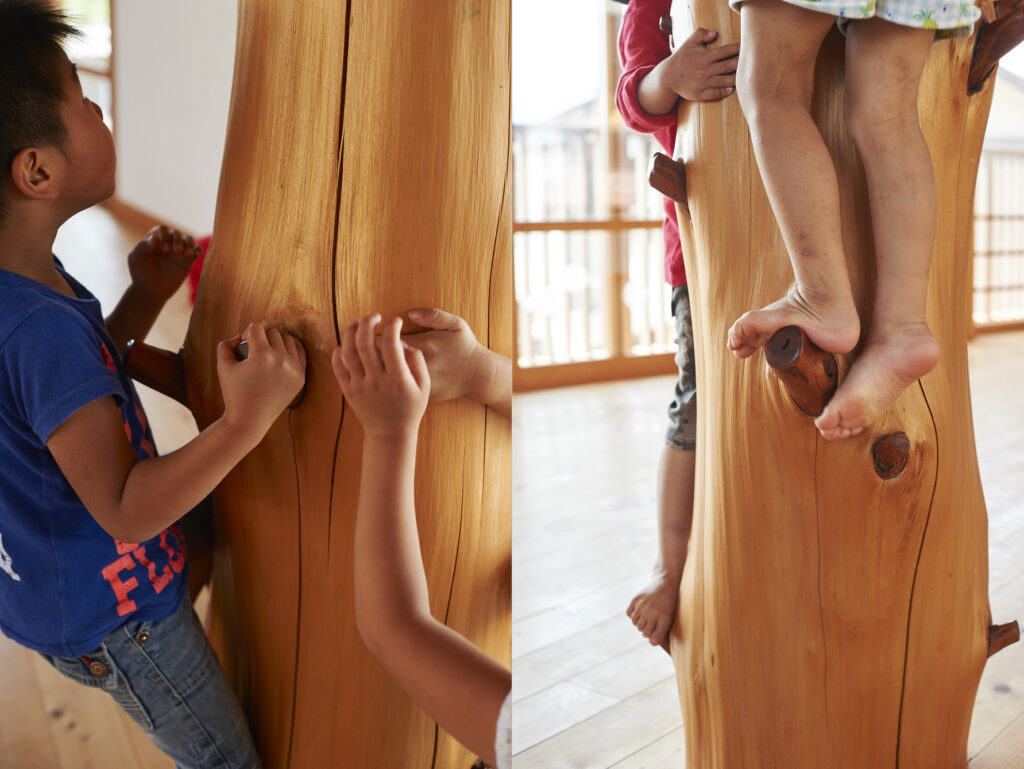
5 自然を受けとめ、自然を楽しむ
建築は、自然の影響をかなりの程度コントロールすることができます。気候を楽しむためには、厳しい暑さや寒さや、湿気を和らげるための工夫が必要となります。深い庇、土に覆われた屋根、風の道、防風林、パーゴラ、木陰などは、私たちがよく用いる装置です。 デザインの過程でもっとも重要なことは、建築と自然環境との調和を図ることです。建物の中で暑さや寒さを感じたり、季節の移り変りを感じたりできることは、大切な要素です。自然と共に暮らしてきた永い時間の中で、人間の身体は体内で時間の流れを感じるように進化してきました。私たちは、体内時計のリズムを守りながら、季節の移ろいに対する感受性を高めるような空間をデザインしたいのです。
5 Enhancing and Enjoying Nature
The structure and the space it defines impose a degree of control on the climate. To enjoy the climate there should be devices to soften the severe elements of heat, cold and humidity. Deep eaves, earth-covered roofs, wind passages and air-wells are some of the softening devices we employ. The imperative of our design process is to search for balance between a mechanically controlled environment and nature in architecture. Feeling hot or cold and being able to mark the changes of seasons within the structure is an important factor. From eons of living with nature, our bodies have evolved an internal awareness of the march of time. We want to design spaces that enhance our sensitivity to the events of the seasons, keeping the rhythm of our internal clock.
5 接受自然、享受自然
建築能在很大的程度上抑制自然對我們的影響。如果想要享受氣候,就必須設法減低酷暑、嚴寒以及濕氣的負面影響。像深廣的出檐、覆蓋土的屋頂、有風通行的道路、防風林、遮陽廊、樹蔭等都是我們經常使用的建築結構。在設計過程中最重要的一點是,即使身處建築物內,也要讓人們感受得到氣溫冷熱及季節遷移。因為在人類和自然共生至今的漫長歲月中,人們已進化到能用自己的身體去感受「時間」的流動。所以我們的理想是設計一個能使人們保有體內時鐘規律,並藉此提高其對於四季變化感受性的空間。
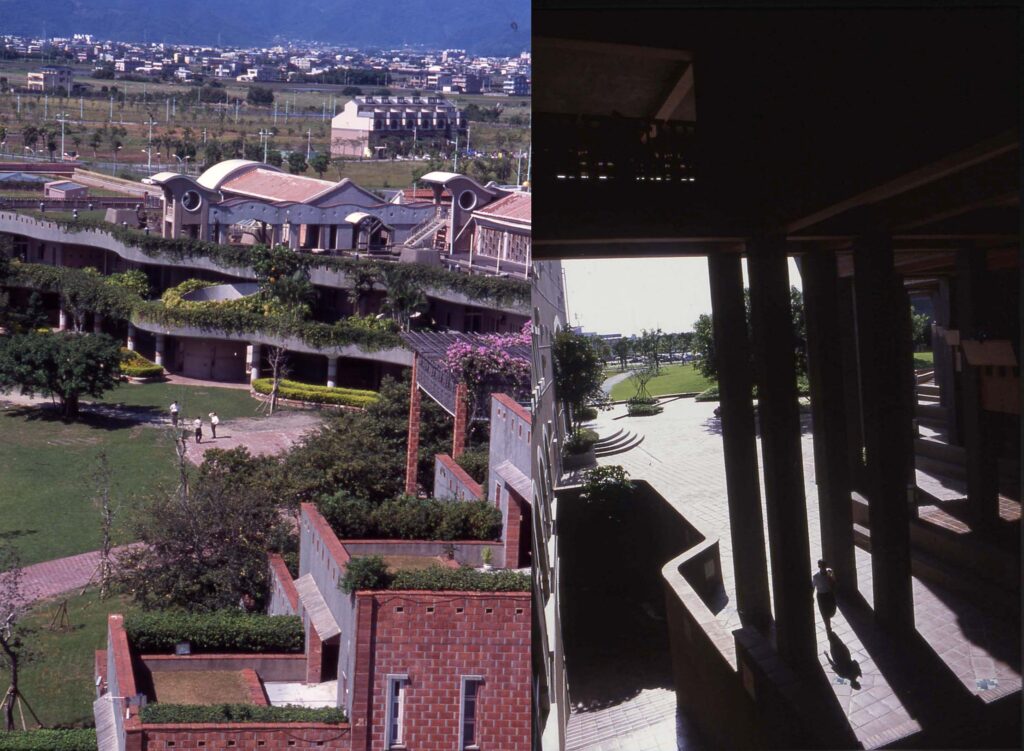
6 あいまいもこ
あいまいもこは、限定されないで、どっちつかずで、はっきりしないことです。 建築か庭か街か、内部空間か外部空間か、建物か衣服か、遊びか仕事か、今か昔か未来か、完成か未完成か、株序があるのかないのか、部分か全体か、本気か冗談か、生徒か先生か、誰がデザインしたのか、…… 私たちはこのようなことがらについて、あいまいもこな世界に住み続けていきたいのです。
6 Aimaimoko
‘Aimaimoko’is the state of being unlimited and ambiguous, taking no positions for this or that side. Architecture, town or garden, interior or exterior spaces, buildings or clothes, play or work, yesterday today or tomorrow, finished or unfinished, disciplined or undisciplined, part or whole, serious or silly, teacher or student-who designs, who makes things? We want all these and many more things to be ambiguous, to stay alive in the aimaimoko world.
6 曖昧模糊
曖昧模糊指的是不受拘束、模稜兩可、沒有明確歸屬的意思。 有點像建築有點像庭院也有點像街道、不知是室內空間還是室外空間、究竟是建築化的衣物還是衣物化的建築、是遊戲還是工作、分不清是現在過去還是未來、看似完成又似未完成、井然有序亦或混亂失序、是部分還是全體、半正經半玩笑、誰是學生誰是老師、誰才是設計這些的人……?我們希望跟從這樣的事物,持續活在曖昧模糊的世界裡。
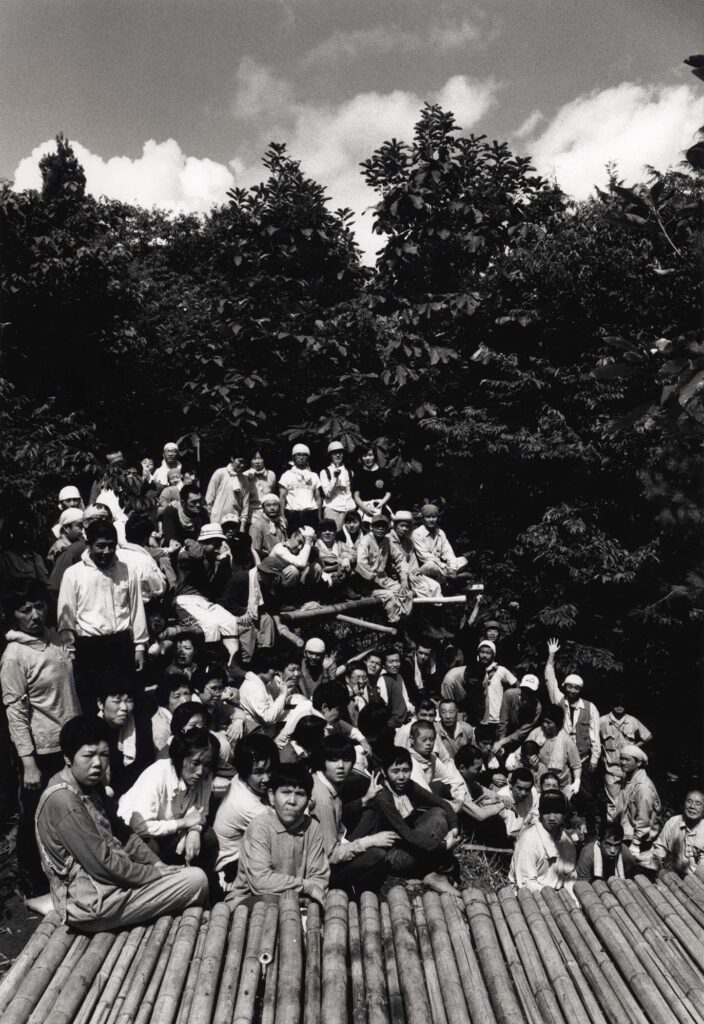
7 自力建設
自力建設とは、単に具体的な建設を指すのではありません。自らの地域を、自らの手でつくり上げてゆく哲学です。近代の制度を超え、地域を超える生命の叫びです。方法論を場所にもち込むのではなく、場所がもつ初源的な力を発見し、それらを収斂させることなのです。 機械よりは多くの雑多な人々、知識よりは知恵、速さよりは持続力、理性よりは情熱、狂気、妥当よりは過剰、規範よりは埓外のものごと、結論よりは終わりのない問いかけ、形姿に求められるものは魔力。 最後に、空間の緑化がもっとも大切です。
7 Exertive Building
“Exertive Building”-or the act of building with one’s own exertion-does not merely means building something concrete by oneself. It is our philosophy to create autonomously one’s or our own place. It is not to impose certain methodology on a given place; rather it is to descover and let converge the primordial forces of the place. We favor:
a bunch of people rather than machines; human wisdom rather than knowledge; continuity rather than speed; passion and zeal rather than reason; excessiveness rather than adequacy; extranorm rather than the norm; endless questions rather than a conclusion. Exertive building is life’s outcry, which transcends modern institutions and regional boundaries. In such an effort we seek to imbue forms and appearances with magical power. Finally, the greening of the space is most important.
7 自力建設
所謂的自力建設,並不單指具體的建築方式。而是利用自己的手創造自己社區的哲學。這是一種超越現代制度,跨越地域的生命吶喊。所以我們不會將方法論帶入建築所在地,而是去發掘當地擁有的原生力量,並將其收束於設計的建築之中。
在這個過程中,眾多形形色色人們的參與會比機械的力量更為強大、智慧比知識重要、堅持不懈的持續力優於快速的速度、熱情、瘋狂比理性好、過度勝於中庸、例外重於規則、永不終止的疑問比起畫上句點的結論高明、魔力是我們對造型與姿態的終極追求。最後,最重要的是進行空間的綠化。
